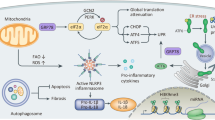Abstract
Connective tissue remodeling of the extracellular matrix (ECM) is an essential and dynamic process associated with both physiological responses, such as wound healing, and pathological conditions, such as renal tubulointerstitial fibrosis (TIF). Data from the published literature indicate that collagens and several non-collagenous ECM glycoproteins actively contribute to TIF. The early phase of TIF is usually associated with an inflammatory process mediated by soluble factors released by activated resident cells and by infiltrating cells. Fibrogenic cytokines and growth factors secreted by inflammatory cells and fibroblasts are actively involved in connective tissue remodeling, possibly by regulating the rate of synthesis and degradation of the ECM. An uncontrolled balance of this process usually results in TIF. We review the physiology of wound healing and the pathology of fibrosis, emphasizing TIF.
Similar content being viewed by others
Author information
Authors and Affiliations
Additional information
Received: January 28, 2002 / Accepted: February 6, 2002
Rights and permissions
About this article
Cite this article
Razzaque, M., Taguchi, T. Cellular and molecular events leading to renal tubulointerstitial fibrosis. Med Electron Microsc 35, 68–80 (2002). https://doi.org/10.1007/s007950200009
Issue Date:
DOI: https://doi.org/10.1007/s007950200009




